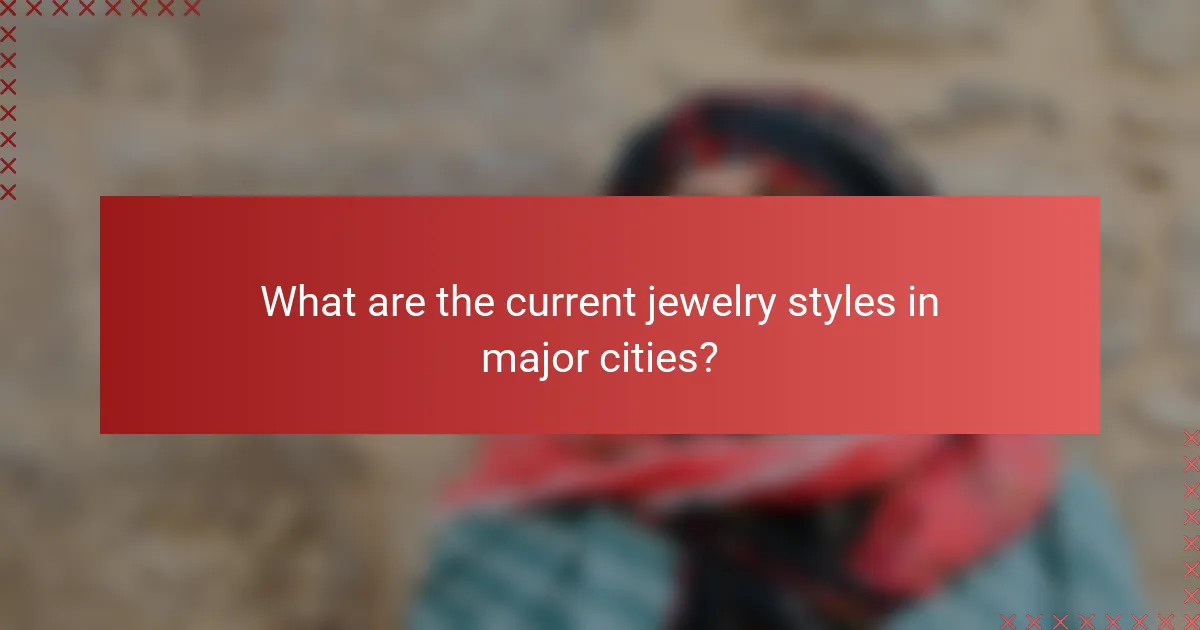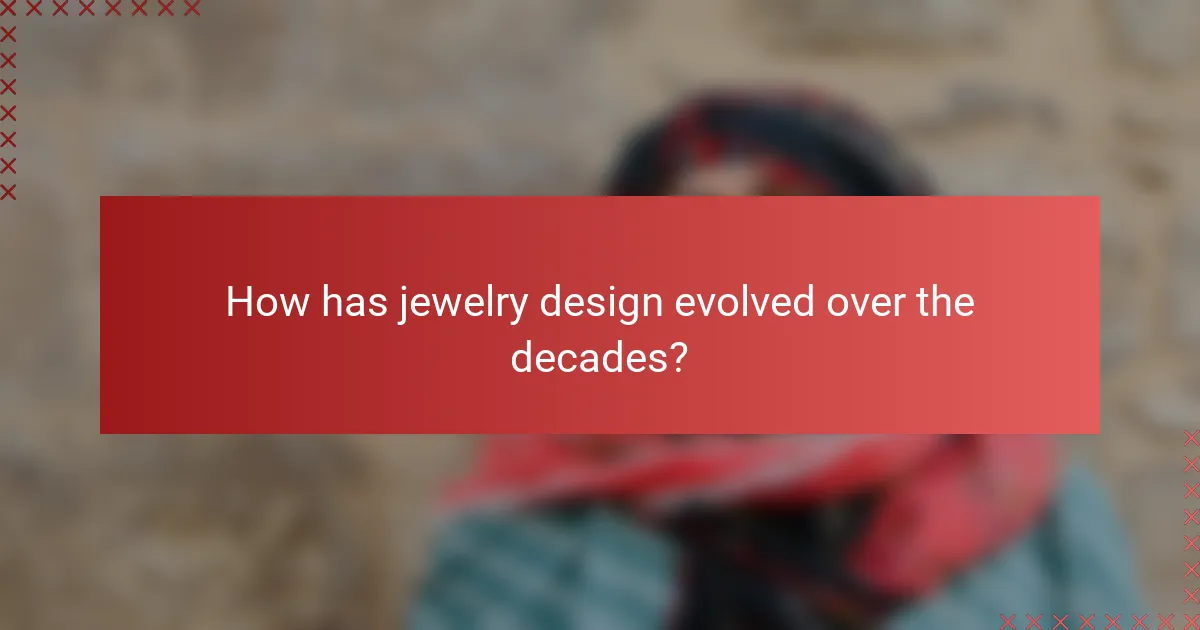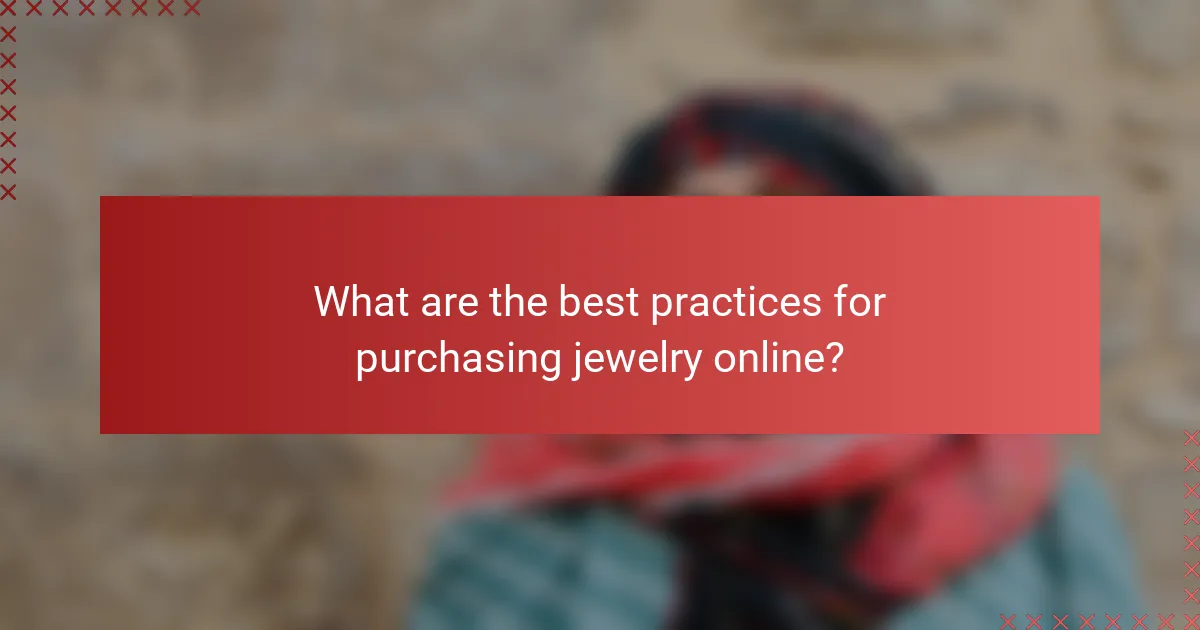The evolution of jewelry styles showcases a rich tapestry of cultural influences and artistic movements, transitioning from the ornate designs of the early 20th century to today’s minimalist aesthetics. Current trends are heavily shaped by social media and celebrity endorsements, leading to a diverse array of choices that emphasize personal expression and ethical sourcing. As major cities become melting pots of creativity, the jewelry landscape continues to reflect both individual tastes and broader societal shifts.

What are the current jewelry styles in major cities?
Current jewelry styles in major cities reflect a blend of cultural influences and personal expression. Trends vary widely, with minimalist designs, bold statement pieces, vintage inspirations, and a growing emphasis on ethical sourcing shaping the landscape.
Minimalist jewelry trends
Minimalist jewelry emphasizes simplicity and elegance, often featuring clean lines and understated designs. This style is popular in cities like Tokyo and Copenhagen, where less is more, and pieces often include delicate chains, small studs, and subtle rings.
When choosing minimalist jewelry, focus on quality materials such as gold, silver, or platinum. Look for versatile pieces that can be layered or worn alone, allowing for easy integration into various outfits.
Statement pieces in urban fashion
Statement jewelry is characterized by bold, eye-catching designs that serve as focal points in an outfit. In cities like New York and London, oversized earrings, chunky necklaces, and vibrant bracelets are commonly seen, often paired with simpler clothing to create a striking contrast.
To effectively incorporate statement pieces, consider the balance of your overall look. Choose one standout item and keep the rest of your accessories minimal to avoid overwhelming your ensemble.
Vintage-inspired designs
Vintage-inspired jewelry draws from past eras, often featuring intricate designs and unique craftsmanship. Styles from the Art Deco period or the Victorian era are particularly popular in cities like Paris and Milan, where nostalgia meets modern aesthetics.
When selecting vintage-inspired pieces, pay attention to the quality of materials and craftsmanship. Look for items that reflect the era’s characteristics, such as filigree work or gemstone settings, to ensure authenticity and style.
Ethical and sustainable jewelry
Ethical and sustainable jewelry focuses on environmentally friendly practices and fair labor standards. In cities like San Francisco and Amsterdam, consumers increasingly seek out brands that use recycled materials or ethically sourced gemstones.
To support ethical jewelry, research brands that prioritize sustainability and transparency. Look for certifications or labels that indicate responsible sourcing, and consider investing in timeless pieces that will last, reducing the need for frequent replacements.

How has jewelry design evolved over the decades?
Jewelry design has transformed significantly over the decades, reflecting cultural shifts, technological advancements, and artistic movements. From the ornate styles of the early 20th century to the minimalist designs of today, each era has contributed unique elements to the craft.
Influence of the Art Deco movement
The Art Deco movement, which flourished in the 1920s and 1930s, introduced bold geometric shapes and vibrant colors to jewelry design. This style emphasized luxury and modernity, often incorporating materials like platinum, diamonds, and colored gemstones.
Art Deco pieces are characterized by their symmetrical designs and intricate detailing, making them highly sought after by collectors today. Popular motifs included sunbursts, zigzags, and stylized floral patterns, which conveyed a sense of elegance and sophistication.
Impact of the 1960s counterculture
The 1960s counterculture brought a dramatic shift in jewelry design, emphasizing individuality and self-expression. This era saw the rise of bohemian styles, with an emphasis on natural materials like wood, beads, and stones, often in unconventional combinations.
Jewelry became a form of protest and identity, with pieces often reflecting social movements and personal beliefs. The use of peace symbols, psychedelic colors, and handmade designs became popular, allowing wearers to showcase their values and creativity.
Rise of technology in jewelry making
Advancements in technology have revolutionized jewelry making, introducing techniques like 3D printing and computer-aided design (CAD). These innovations allow for greater precision and customization, enabling designers to create intricate pieces that were previously difficult to achieve.
Today, technology not only enhances design capabilities but also streamlines production processes, reducing costs and time. As a result, consumers can access a wider variety of styles and options, often at more affordable prices, while maintaining high quality.

What are the key factors influencing jewelry trends today?
Jewelry trends today are primarily influenced by social media, celebrity endorsements, and collaborations within the fashion industry. These factors shape consumer preferences and drive the popularity of specific styles and designs.
Social media and influencer impact
Social media platforms like Instagram and TikTok play a crucial role in shaping jewelry trends. Influencers showcase various styles, often leading to rapid shifts in consumer interest as followers seek to emulate their favorite personalities.
Brands can leverage social media by partnering with influencers to reach broader audiences. This strategy often involves sponsored posts or collaborations that highlight unique pieces, making them more desirable to potential buyers.
Celebrity endorsements
Celebrity endorsements significantly impact jewelry trends by associating specific pieces with high-profile figures. When a celebrity is seen wearing a particular brand or style, it often leads to increased demand and visibility for that jewelry.
For example, red carpet events frequently showcase exclusive designs, prompting fans to seek similar items. Brands often capitalize on this by creating limited-edition pieces inspired by celebrity looks, further driving consumer interest.
Fashion industry collaborations
Collaborations between jewelry brands and fashion designers can create buzz and introduce innovative styles. These partnerships often result in unique collections that blend the aesthetics of both parties, appealing to a wider audience.
Such collaborations can be particularly effective during fashion weeks or major events, where exclusive pieces are unveiled. Consumers are often eager to purchase these items, as they represent a fusion of high fashion and unique craftsmanship.

How do I choose the right jewelry style for my personal brand?
Choosing the right jewelry style for your personal brand involves aligning your accessories with your values, aesthetics, and the message you wish to convey. Consider your lifestyle, the image you want to project, and how different styles resonate with your personality.
Identifying your style personality
Your style personality is a reflection of your tastes and preferences, which can be categorized into several types such as classic, bohemian, modern, or eclectic. To identify yours, think about the clothing you feel most comfortable in and the colors or materials that attract you. For instance, if you prefer timeless pieces and neutral tones, a classic style may suit you best.
To further refine your style personality, create a mood board with images of jewelry that appeal to you. This visual representation can help clarify your preferences and guide your choices when selecting pieces that align with your personal brand.
Assessing occasion-specific needs
Make a checklist of your upcoming events and the type of jewelry that would be appropriate for each. This approach ensures that your jewelry not only complements your outfit but also enhances your personal brand in various settings. Remember to balance bold pieces with simpler ones to maintain versatility in your collection.

What are the best practices for purchasing jewelry online?
To purchase jewelry online effectively, prioritize researching the seller, understanding return policies, and verifying product authenticity. These steps help ensure a satisfactory buying experience and reduce the risk of fraud.
Understanding return policies
Before finalizing your purchase, thoroughly review the seller’s return policy. A clear and fair return policy allows you to return or exchange items if they do not meet your expectations.
Look for policies that offer at least 14 to 30 days for returns, and check if the seller covers return shipping costs. Be aware of any conditions that may apply, such as items needing to be unworn or in original packaging.
Evaluating seller reputation
Assessing a seller’s reputation is crucial when buying jewelry online. Start by reading customer reviews and ratings on the seller’s website and third-party platforms.
Look for sellers with a consistent track record of positive feedback and high ratings, ideally above 4 out of 5 stars. Additionally, check if the seller is accredited by organizations like the Better Business Bureau (BBB) or similar entities in your country.
